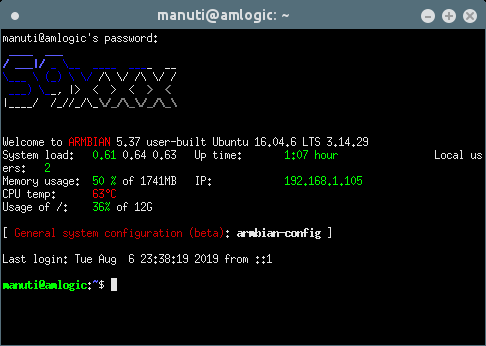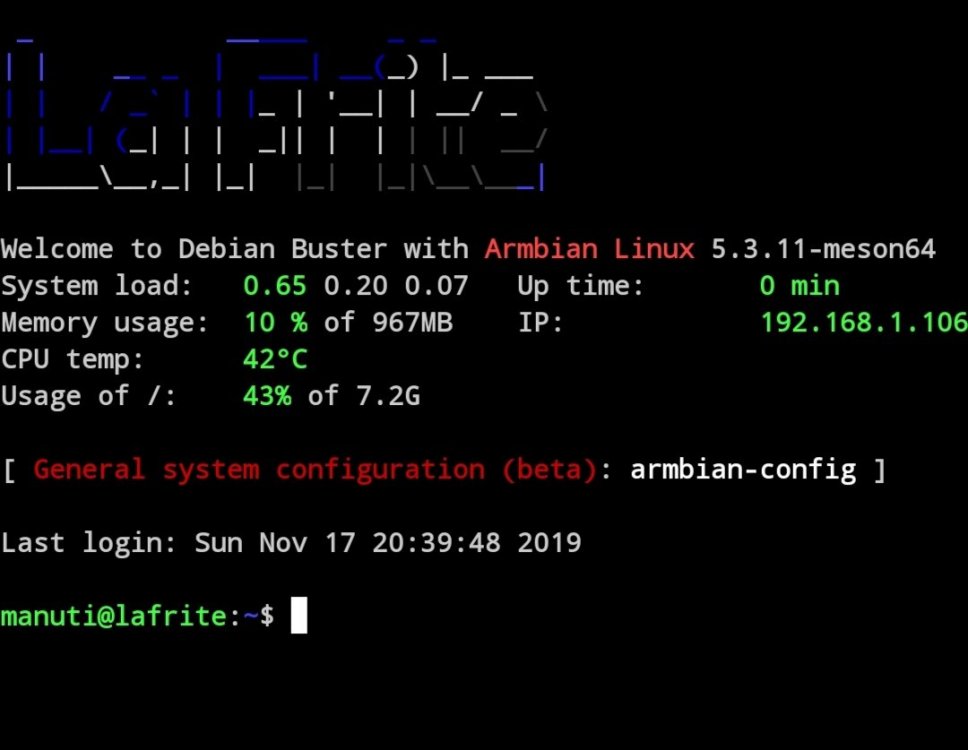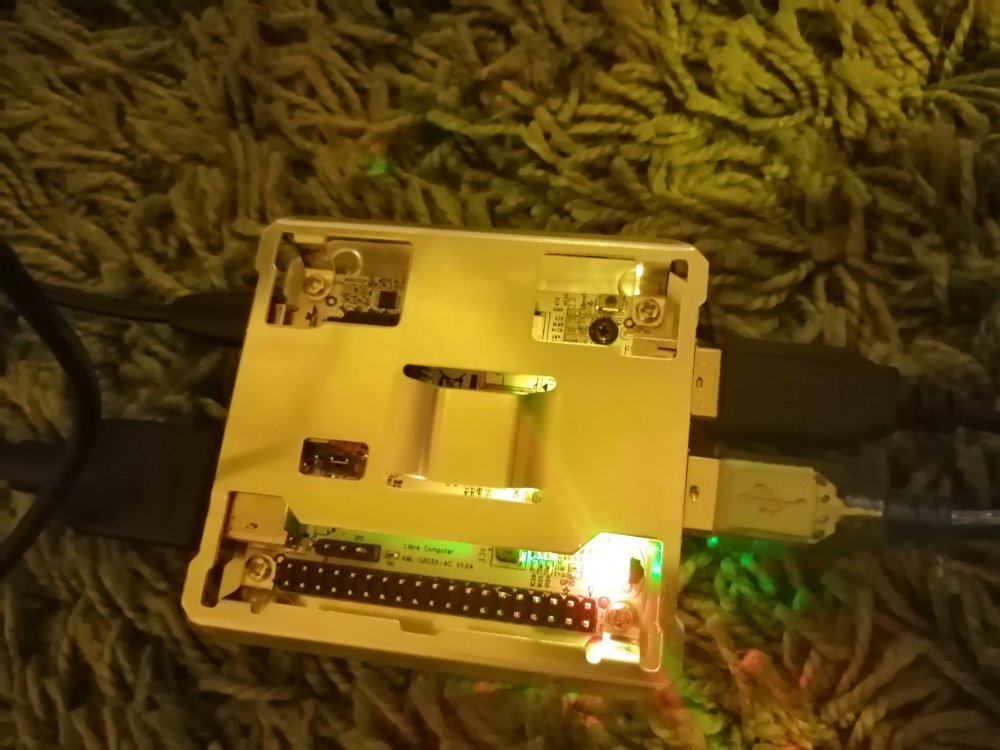-
Posts
353 -
Joined
-
Last visited
Content Type
Forums
Store
Crowdfunding
Applications
Events
Raffles
Community Map
Posts posted by manuti
-
-
On 11/17/2019 at 12:37 AM, manuti said:
The La Frite reboot every time I try to boot in eMMC mode USB. Any way to 'dd' the image on the eMMC?
Solved: finally found a way. With keyboard attached (black cable in the below picture) to the further USB port from GPIO and USB male to male (light blue in the below picture) in the closest USB to GPIO and with additional power feeding from the micro USB.
-
The La Frite reboot every time I try to boot in eMMC mode USB. Any way to 'dd' the image on the eMMC?
I can see the eMMC module from Armbian using lsblk command.
I can't see eMMC install in armbian-config or use nand-sata-install because the system must run from SD card.
Any idea to move armbian to the eMMC?
Thanks
-
11 hours ago, djismgaming said:
No problem
 here to help any way I can.
here to help any way I can.
Thanks a million!
-
4 hours ago, djismgaming said:
Technically I flashed the image directly to the La Frite eMMC with etcher on a Debian 10 laptop via USB...
Thanks. One more question.
In which USB port you attach the keyboard and in which the male to male USB cable?
Kind regards.
-
On 9/4/2019 at 2:51 PM, djismgaming said:
installing armbian-config and the full desktop on top of the minimal image runs like a champ on this La Frite! Thanks so much guys for this awesome work (in progress :D)
and temperatures around 15C (on idle, ~60C on LibreComputer current desktop images) less than with the desktop images direct from LibreComputer, WOW! Even overclocked to 1.5GHz! You guys rock for a nightly image!
Hi @djismgaming how you did you manage to move armbian to the eMMC?
Thanks
-
Nice to be useful ... in Spain we said to avoid forget something you need to eat raisin stalks.
-
Hi, your images @jernej are right here https://dl.armbian.com/_openelec/ I don't know if you know this or not.
Regards
-
-
Hi, I have an old install in eMMC/NAND in a MXQPro+ and I want to update to the recent version that's let me keep the OS in the internal memory. The output from uname is:
Linux amlogic 3.14.29 #144 SMP PREEMPT Tue Dec 26 10:26:54 MSK 2017 aarch64 aarch64 aarch64 GNU/LinuxAnd the output in the SSH login screen is:

Thanks in advance.
-
Many of then barely used ... but always searching for the definitive SBC:
- Raspberry Pi B everything stars here.
- Raspberry Pi B+ : Solving many issues from the previous version.
- Raspberry Pi A+ : Really low power consumption, this will be a good starting point to something with dual core balancing power & consumption.
- Raspberry Pi 2B the Good
- Raspberry Pi 3B the Ugly
- Raspberry Pi Zero : Main Kodi OSMC board, really, I don't need more.
- Raspberry Pi Zero W : Used as a CCTV.
- Raspberry Pi 3B+ the Bad
- ODROID-U3 : The best SBC I have with eMMC and 2GB. But today without updates from hardkernel.
- ODROID-C1 : Many problems before C1+ arrive ... good board but not better than U3.
- UG802 RK3066 : Reconverted Android TV with Picuntu, used on a weekly basis sharing more than 1000 small torrents and waiting for a death that never arrives.
- Banana Pi PRO : main home NAS with last armbian and OMV, Plex and Torrents. SATA & Gigabit marks the difference.
- Orange Pi One : When I know this board has armbian support I decided to buy only because is cheap and not hopping so much ... but is a really good board for the price.
- Orange Pi Lite : After having OPi One I want to try this with Wi-Fi and more USB. Used with Lakka as Retrogame platform.
- Orange Pi PC : Looking for a substitute or back-up of my Banana Pi PRO or the Lakka. Good CPU performance but never used a lot.
- Orange Pi PC2 : Again looking for a second NAS board. Good performance and net bandwidth. With SSD and UASP can be a good and cheap board to be used as NAS or light server.
- Beelink X2 : after the success, in my opinion, I'm always searching for good Android TV box to be converted in a cheap Linux PC. This was a good one, difficult to have the Wi-Fi up and running in the beginning. This board shows me also the TV box root problem: same name but different hardware (Wi-Fi, NAND, eMMC, RAM, ...).
- MXQ PRO+ 4k : received to test it. Appreciate the @balbes150 effort but many boards with different hardware and I never have the Wi-Fi on my unit working (with many hours spent on this).
- DragonBoard 410c : I wined on a raffled!!! Really good board. With the last Linaro Debian Buster it feels like a light PC but without a proper case, I can use normally.
- NanoPi Neo2 : Another try to have a small NAS. Good board overall but the position of cables is not the better to be used as a server. Please, FriendlyCore thinks on having power, network and 1 x USB in one side.
- Sunvell R69 : I like small boards and small TV boxes. The case of Android TV boxes is one of my main reasons to love this piece of cr*p. A pity this one is more or less good but the Wi-Fi is a real sh*t only capable of keeping SSH connexions.
- La Frite: last addition to the crew. Only booted once. I'm thinking in use as my new Kodi center when the OS or LibreElec will be released.
- C.H.I.P. the $9 computer: I bought with a lot of hopes in my time and projects. I like the Chrome use to flash the board but when the company disappears I know this is the wrong approach. Good ideas in this board: the female GPIO with pinout printed, the built-in battery control, ...
- Omega2 : is another kind of devices I only used sometimes to be a Wi-Fi Gateway. I think is a really good device for IoT projects.
-
you can read tkaiser outside this forum: https://www.cnx-software.com/2019/06/24/raspberry-pi-4-features-broadcom-bcm2711-processor-up-to-4gb-ram/#comment-563869
-
On 2/14/2019 at 6:31 PM, NicoD said:
I still love my 2B
One of the more honest Raspberry Pi ... today I think the RPi 3A+ is more decent, honest and humble with the user.
I complaint about the bottle neck longtime ago https://raspberryparatorpes.net/dudas/el-cuello-de-botella-de-la-raspberry-pi/ in Spanish of course.
-
-
Check this post:
Maybe is that you are looking for.
-
Orange Pi One dons't have onboard Wi-Fi. Maybe you are thinking on Orange Pi Lite.
Following this RPi tutorial https://null-byte.wonderhowto.com/how-to/enable-monitor-mode-packet-injection-raspberry-pi-0189378/ and using Nexmon drivers you can reach this modes but ... the RTL8189FTV chipset included in the OPi Lite is not supported.
-
@balbes150 some questions
which version of armbiam is best for this TV Box?
Which can be installed on eMMC?
Which dtb is the correct to move to /BOOT?
Thanks
-
I'm lost... I don't know whast happening with your Wi-Fi?
Can you try to use `armbian-config` to set up the wireless or try to updarte or switch to a new kernel and try again:
-
-
On 1/26/2019 at 12:55 PM, Andeser said:
Ok what can I do for install the driver of this chip?
https://www.itgubben.eu/files/ from @slinde
I thinks this driver in included ... but the steps I remember more or less are download and unzip the driver in /lib/ directory . After that in a Terminal:
sudo modprobe ap6181 firmware_path=/lib/firmware/ap6210/ap6181.bin nvram_path=/lib/firmware/ap6210/nvram.txt lsmod sudo ifconfig wlan0 up sudo iwlist wlan0 scan -
18 hours ago, Andeser said:
Ok I've installed this OS but the wi-fi don't work yet. What can I do?
try to follow my steps long time ago ...
-
Beelink X2 have different Wi-Fi hardware, more or less the last version of armbian support all the main part of the internal Wi-Fi that you can find inside the BX2. If not your case, there was a long and old forum post about running different Wi-Fi "modules" (like the Windows drivers) in armbian to bring your Wi-Fi to life. This weekend I try to search this post and help you.
-
-
This is the best and more supported version:
- Armbian Xenial desktop legacy kernel 3.4.y https://www.armbian.com/beelinkx2/#kernels-archive
Is the old kernel but everything works out of the box.
-
On 1/14/2019 at 4:05 PM, JMCC said:
I rather suggest x2go
I take you suggest and try to give a try in near future, thanks!!
For me, the only advantage to using RDP is you don't need to intall anything on Windows and also you can find Microsoft official client in the Mac App Store.
But I normally for remote "desktop" use I prefer to export the X apps via SSH using: ssh -X user@machine




Arm board with hardware accelerated AES out-of-the-box in Armbian?
in Off-topic
Posted
Not AES in the popular Raspberry Pi 4 even if they claim to be ARMv8.